Eleventh graders’ actual use of english listening learning strategies at Duong Van Duong high school
It is undeniable that listening comprehension is a fundamental skill in the process of acquiring a language and plays a crucial part in communication although it is not an easy task which requires both background knowledge and linguistic understanding. Therefore, language learners are supposed to employ listening learning strategies to facilitate the process of decoding oral input. This study aimed at examining if the eleventh graders at Duong Van Duong high school used English listening learning strategies and then exploring the frequency of the students’ use of these strategies. The present study is a mixed-Methods research project in which both qualitative and quantitative data were collected through closed-ended questionnaire and semi-structured interview with the participation of 425 respondents and 20 interviewees. The results of the study indicated that a vast number of the participants employed listening learning strategies at different levels of frequency which were classified into three main groups, namely high use (e.g. cognitive and affective strategies), moderate use (e.g. metacognitive and social strategies) and low use (e.g. compensation and memory strategies)
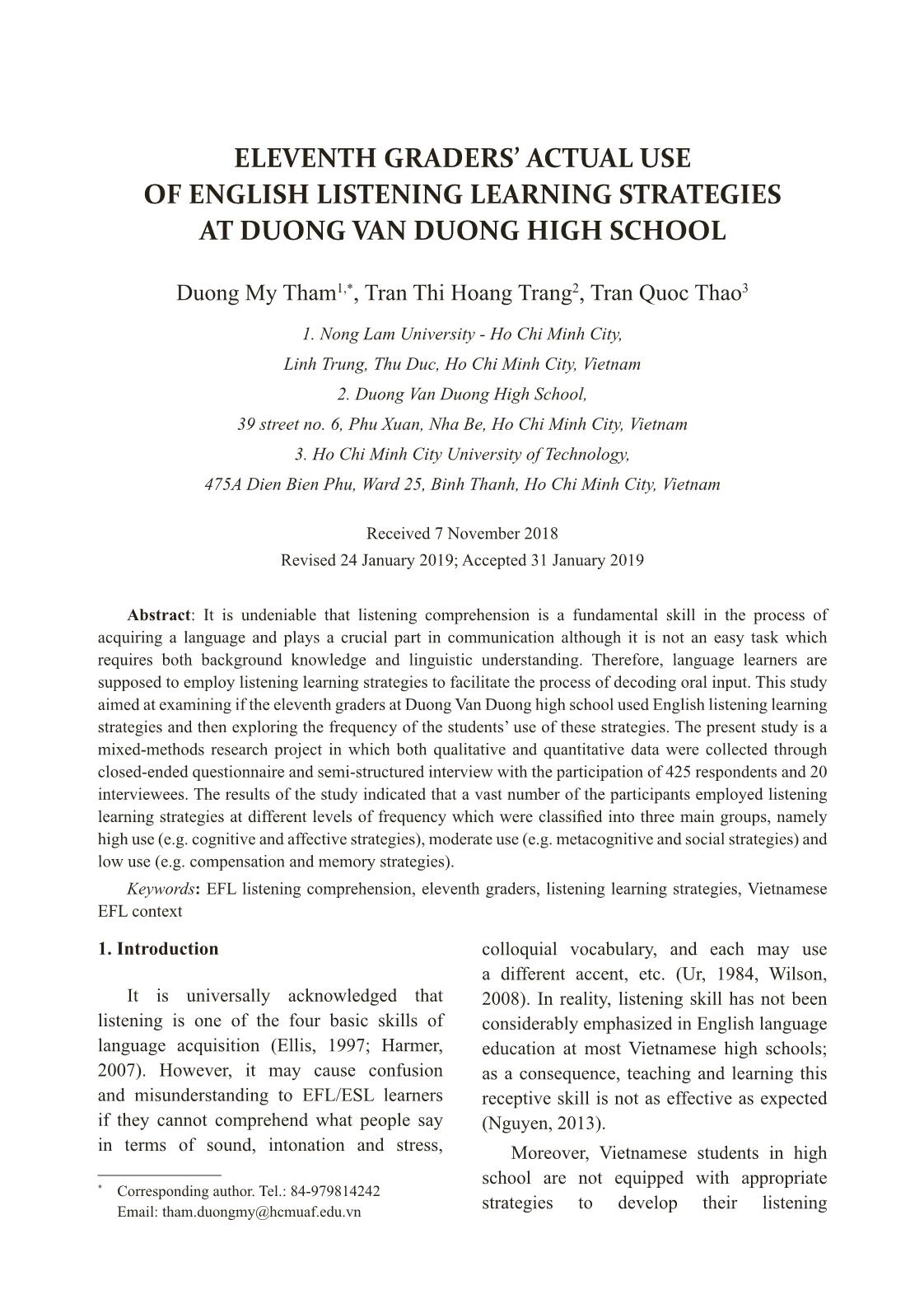
Trang 1
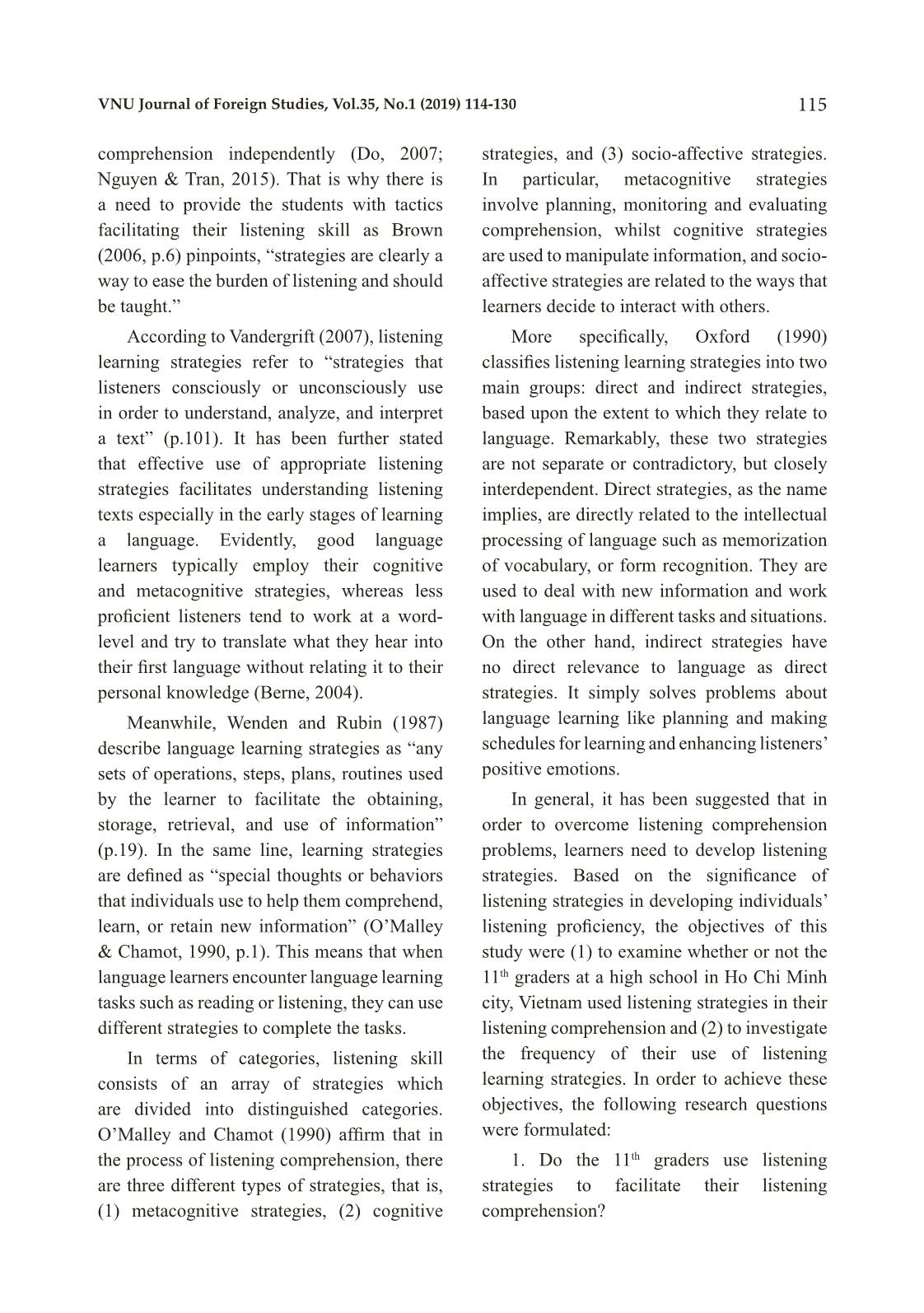
Trang 2
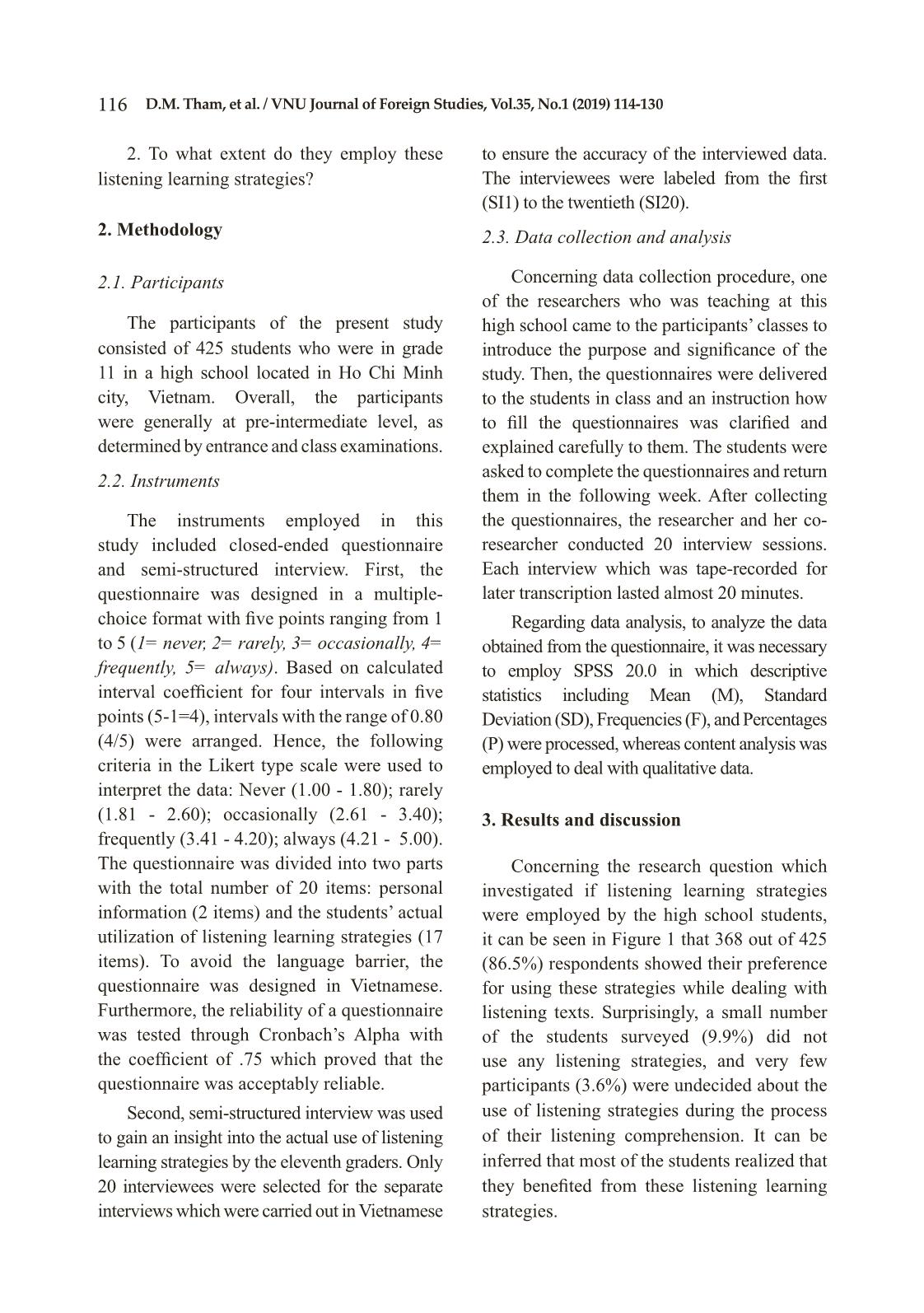
Trang 3
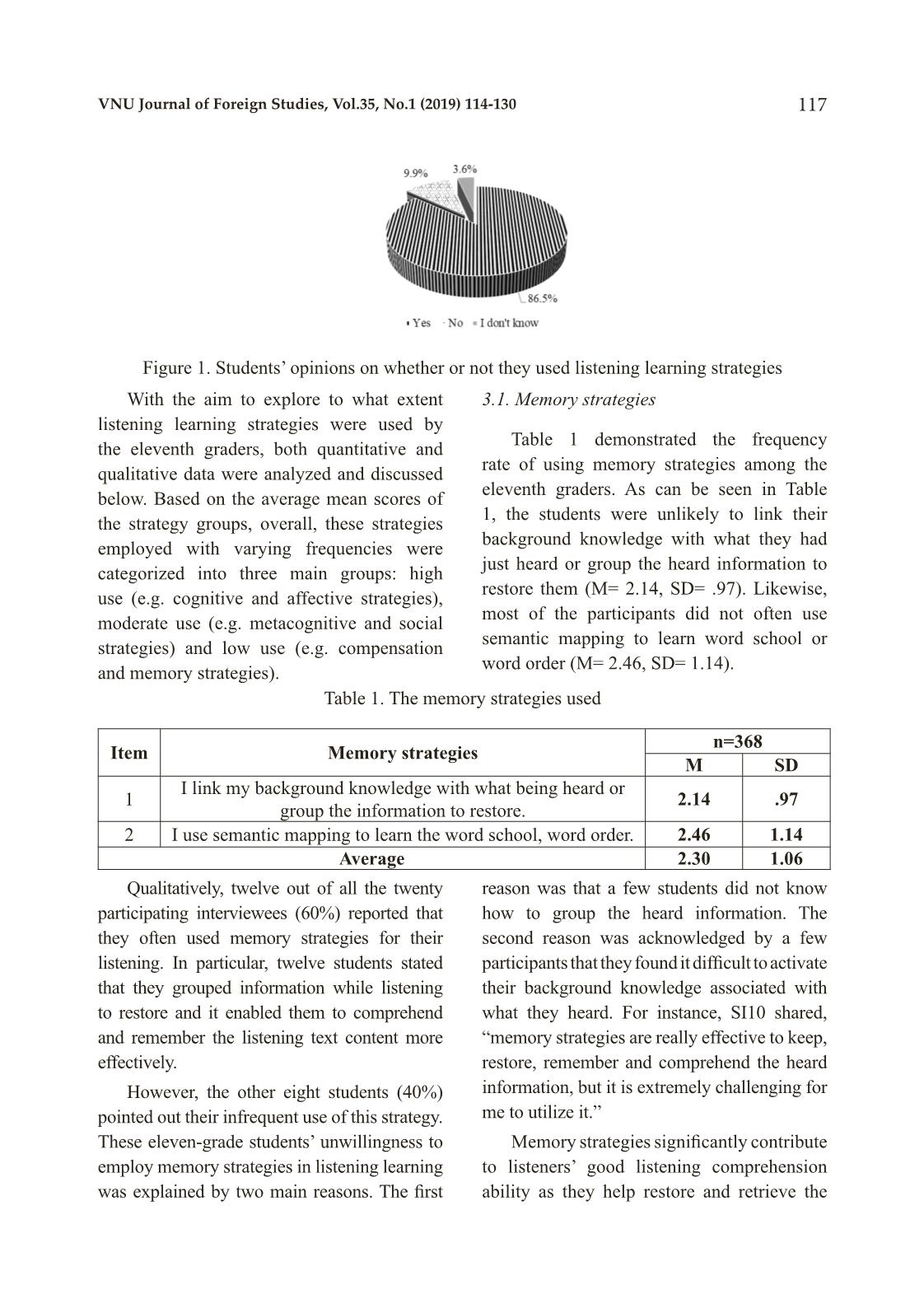
Trang 4
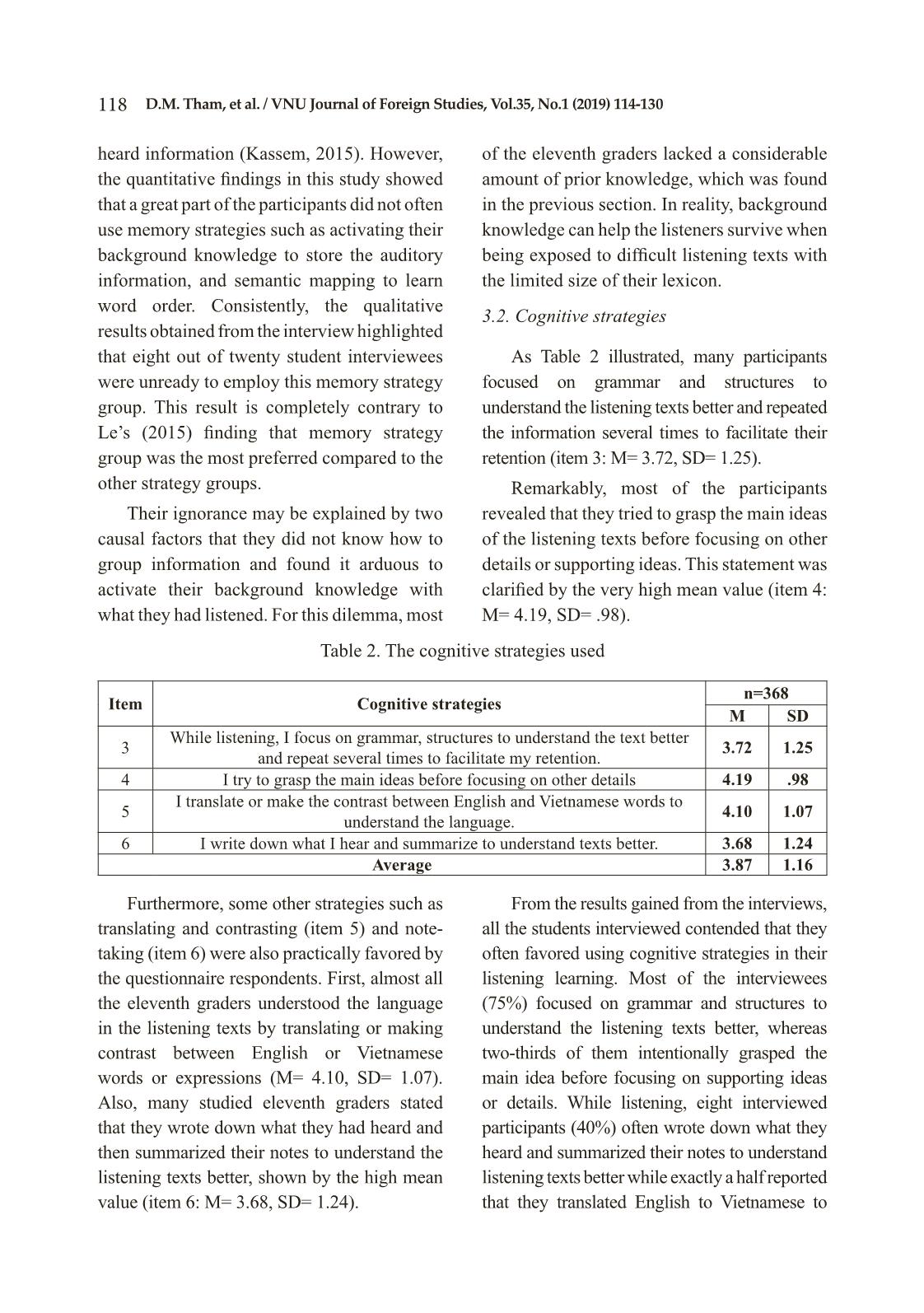
Trang 5
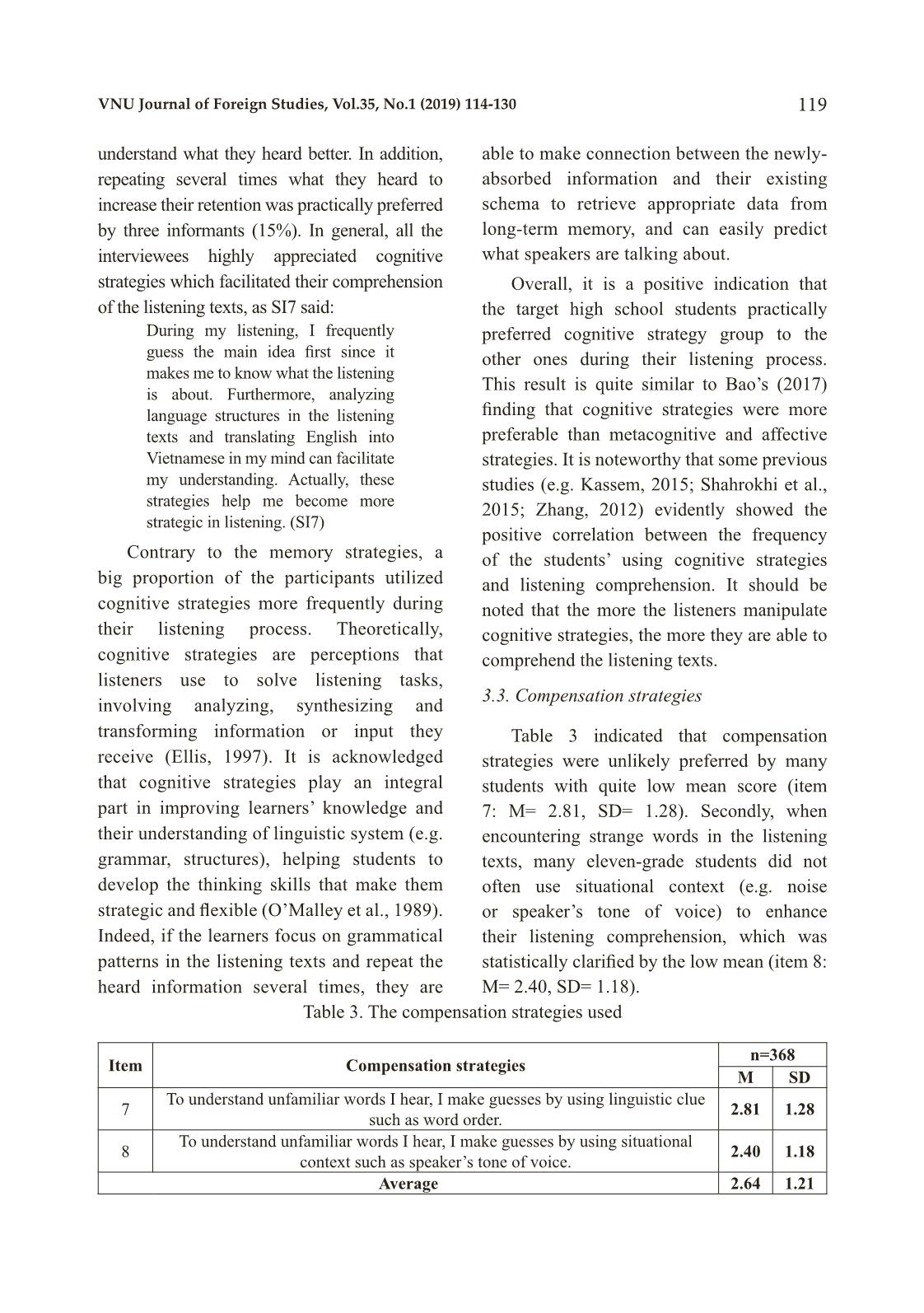
Trang 6
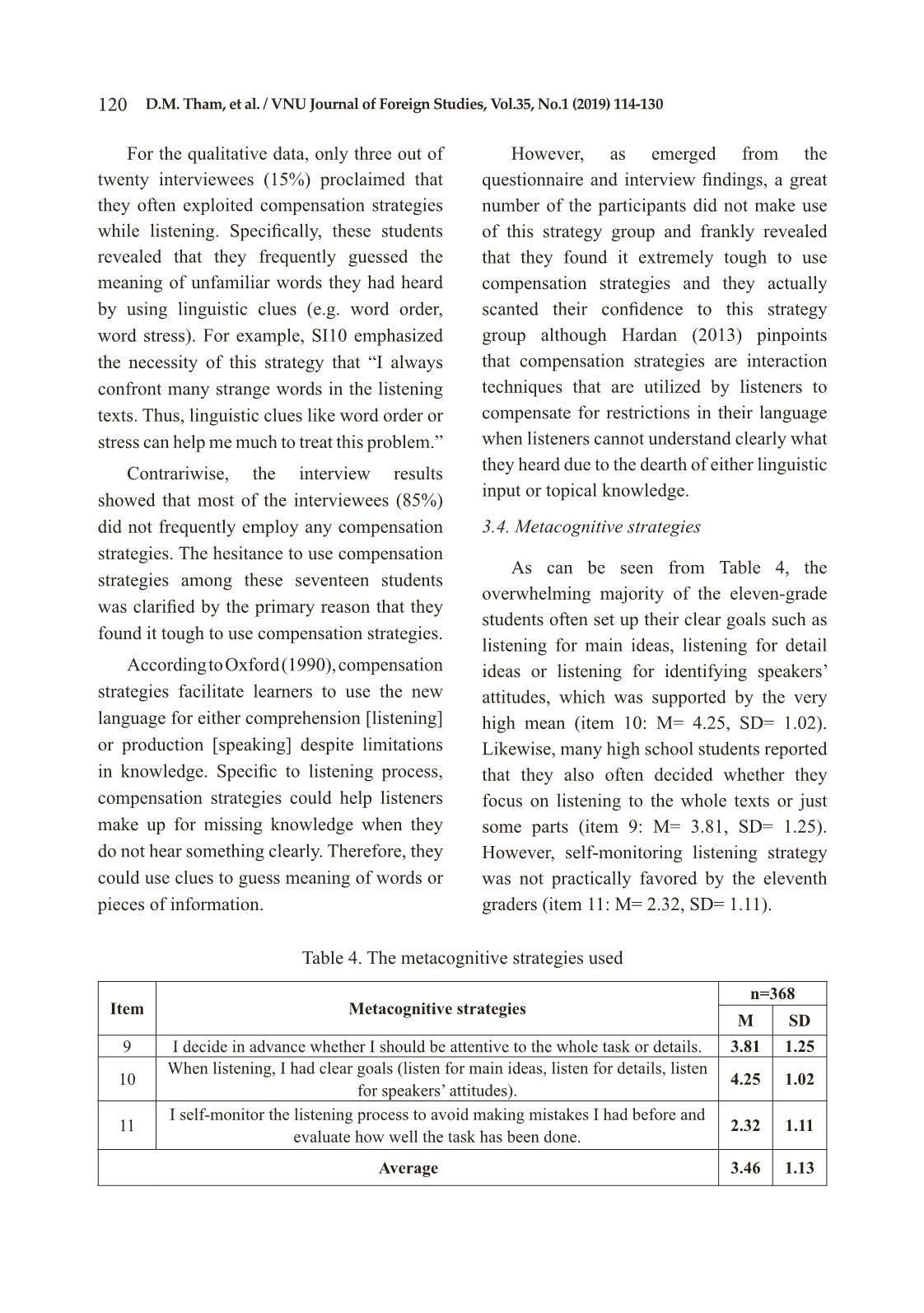
Trang 7
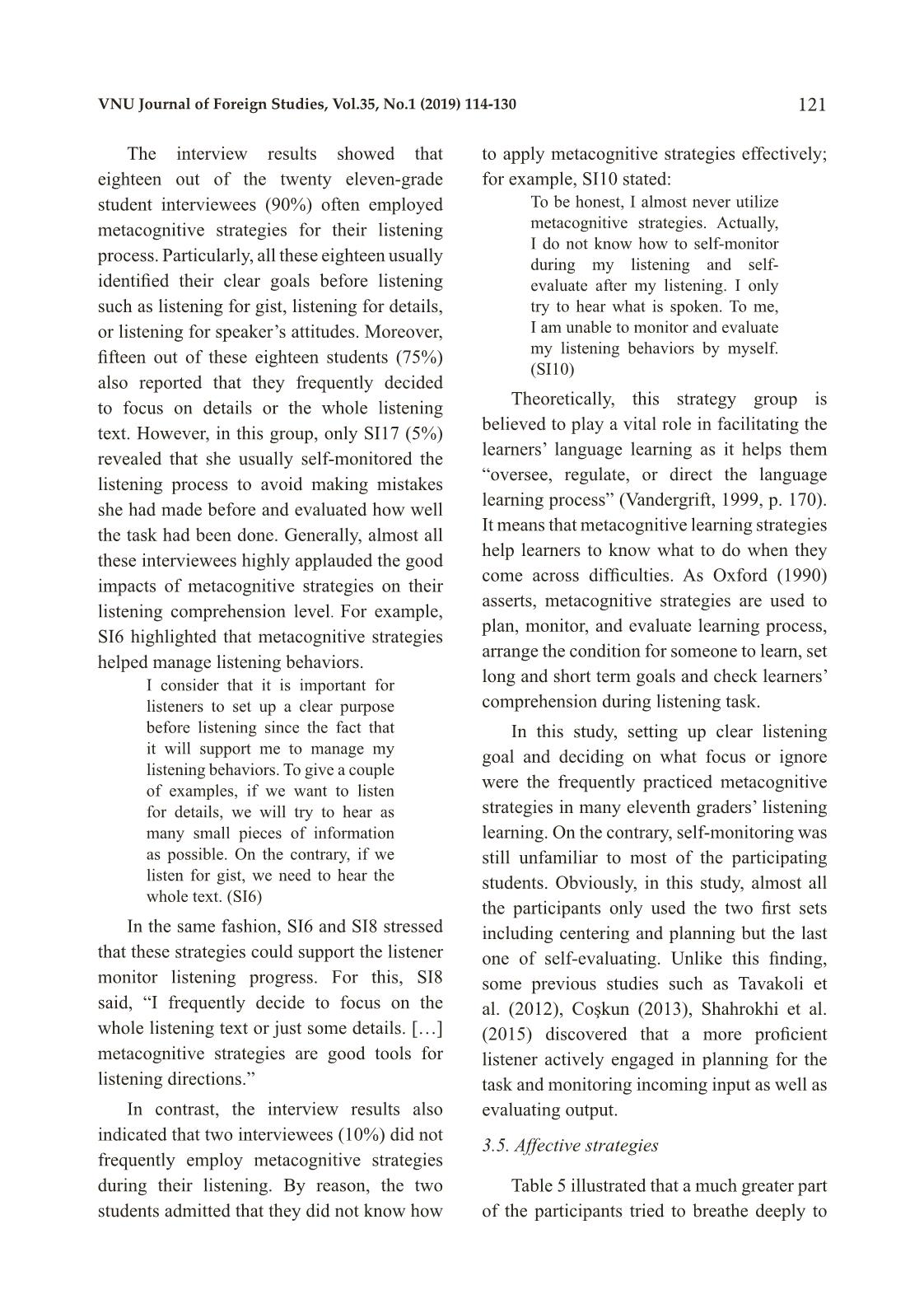
Trang 8
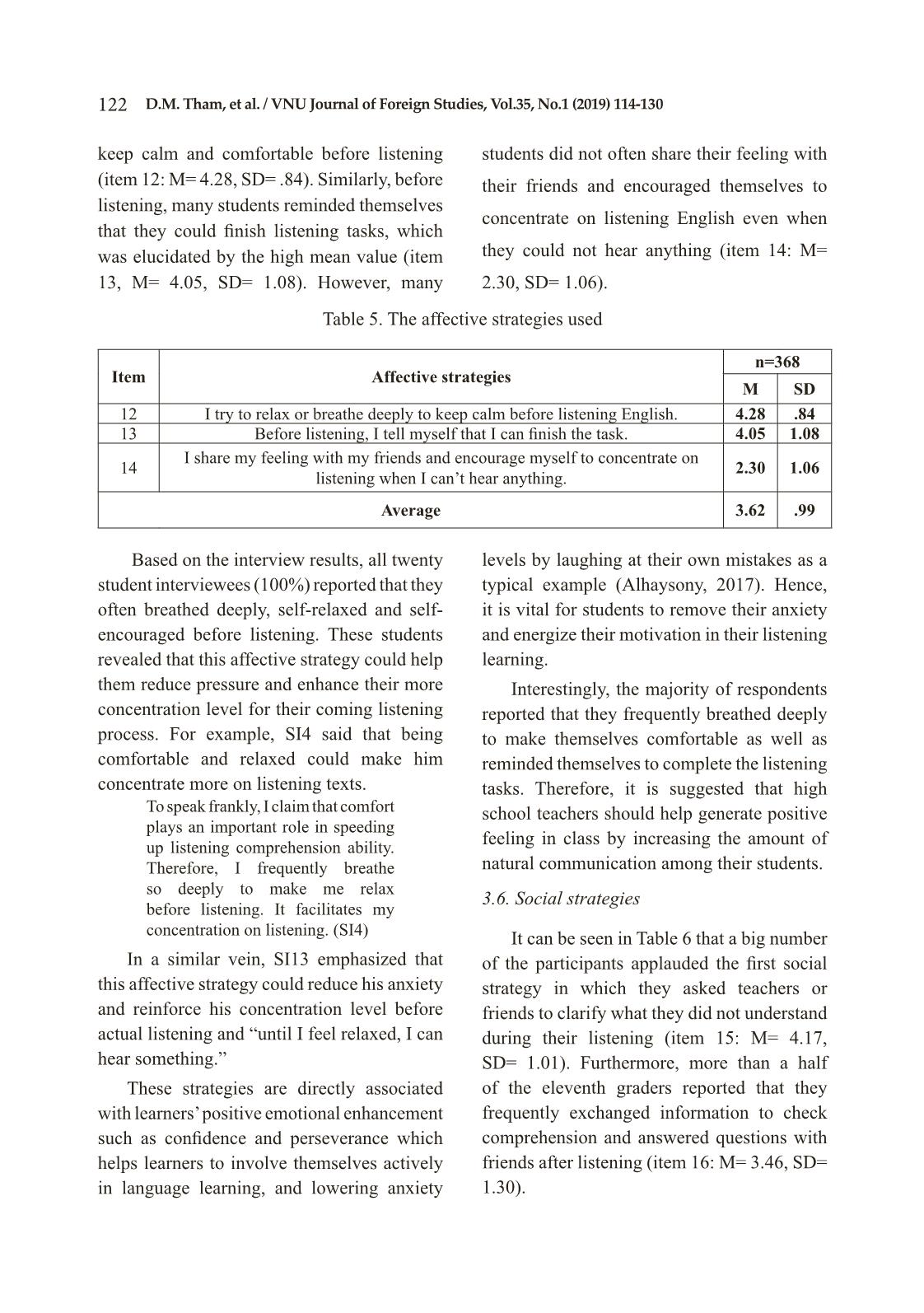
Trang 9
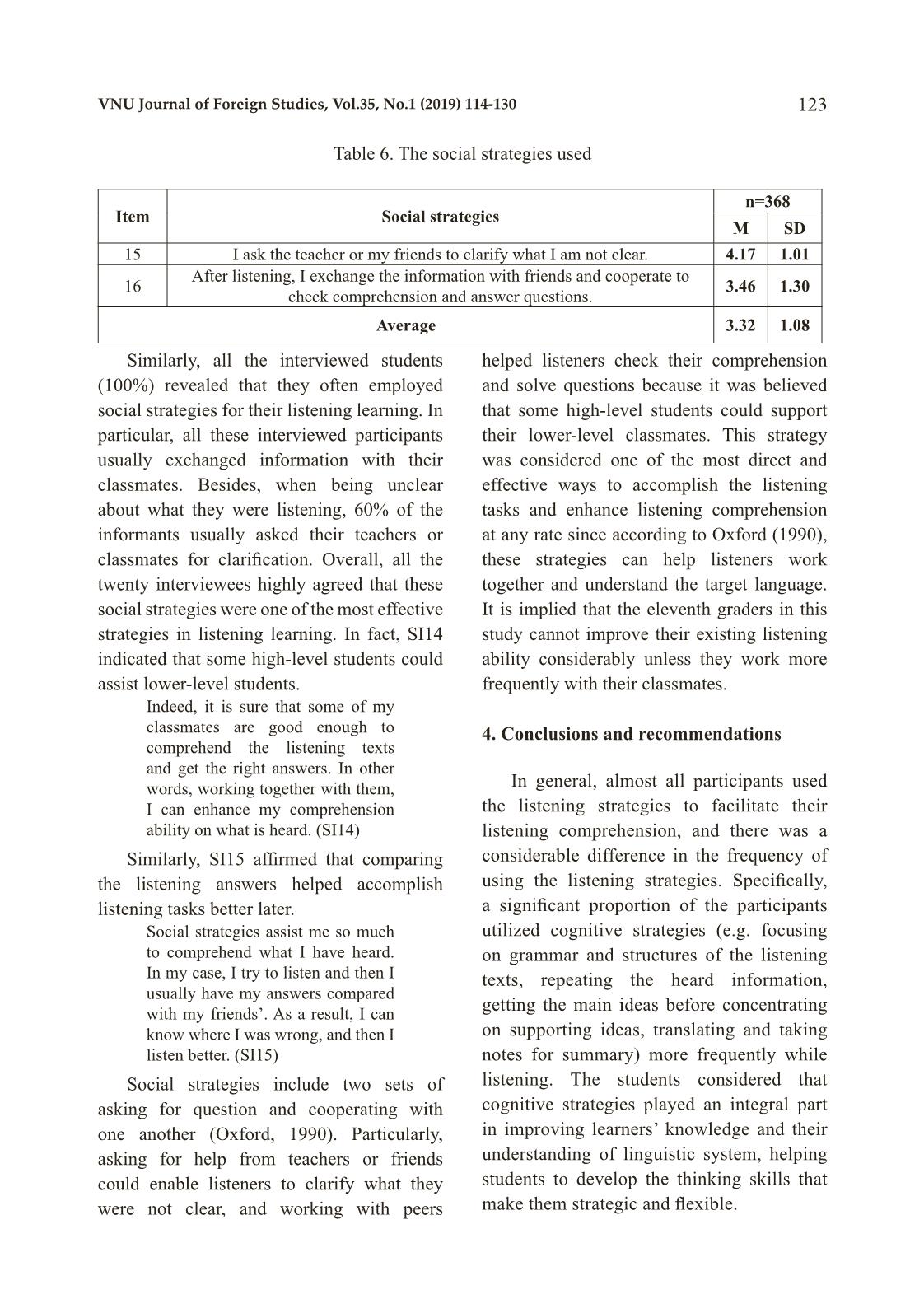
Trang 10
Tải về để xem bản đầy đủ
Tóm tắt nội dung tài liệu: Eleventh graders’ actual use of english listening learning strategies at Duong Van Duong high school
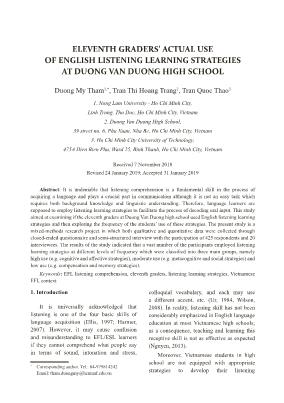
ELEVENTH GRADERS’ ACTUAL USE OF ENGLISH LISTENING LEARNING STRATEGIES AT DUONG VAN DUONG HIGH SCHOOL Duong My Tham1,*, Tran Thi Hoang Trang2, Tran Quoc Thao3 1. Nong Lam University - Ho Chi Minh City, Linh Trung, Thu Duc, Ho Chi Minh City, Vietnam 2. Duong Van Duong High School, 39 street no. 6, Phu Xuan, Nha Be, Ho Chi Minh City, Vietnam 3. Ho Chi Minh City University of Technology, 475A Dien Bien Phu, Ward 25, Binh Thanh, Ho Chi Minh City, Vietnam Received 7 November 2018 Revised 24 January 2019; Accepted 31 January 2019 Abstract: It is undeniable that listening comprehension is a fundamental skill in the process of acquiring a language and plays a crucial part in communication although it is not an easy task which requires both background knowledge and linguistic understanding. Therefore, language learners are supposed to employ listening learning strategies to facilitate the process of decoding oral input. This study aimed at examining if the eleventh graders at Duong Van Duong high school used English listening learning strategies and then exploring the frequency of the students’ use of these strategies. The present study is a mixed-methods research project in which both qualitative and quantitative data were collected through closed-ended questionnaire and semi-structured interview with the participation of 425 respondents and 20 interviewees. The results of the study indicated that a vast number of the participants employed listening learning strategies at different levels of frequency which were classified into three main groups, namely high use (e.g. cognitive and affective strategies), moderate use (e.g. metacognitive and social strategies) and low use (e.g. compensation and memory strategies). Keywords: EFL listening comprehension, eleventh graders, listening learning strategies, Vietnamese EFL context 1. Introduction1 It is universally acknowledged that listening is one of the four basic skills of language acquisition (Ellis, 1997; Harmer, 2007). However, it may cause confusion and misunderstanding to EFL/ESL learners if they cannot comprehend what people say in terms of sound, intonation and stress, * Corresponding author. Tel.: 84-979814242 Email: tham.duongmy@hcmuaf.edu.vn colloquial vocabulary, and each may use a different accent, etc. (Ur, 1984, Wilson, 2008). In reality, listening skill has not been considerably emphasized in English language education at most Vietnamese high schools; as a consequence, teaching and learning this receptive skill is not as effective as expected (Nguyen, 2013). Moreover, Vietnamese students in high school are not equipped with appropriate strategies to develop their listening 115VNU Journal of Foreign Studies, Vol.35, No.1 (2019) 114-130 comprehension independently (Do, 2007; Nguyen & Tran, 2015). That is why there is a need to provide the students with tactics facilitating their listening skill as Brown (2006, p.6) pinpoints, “strategies are clearly a way to ease the burden of listening and should be taught.” According to Vandergrift (2007), listening learning strategies refer to “strategies that listeners consciously or unconsciously use in order to understand, analyze, and interpret a text” (p.101). It has been further stated that effective use of appropriate listening strategies facilitates understanding listening texts especially in the early stages of learning a language. Evidently, good language learners typically employ their cognitive and metacognitive strategies, whereas less proficient listeners tend to work at a word- level and try to translate what they hear into their first language without relating it to their personal knowledge (Berne, 2004). Meanwhile, Wenden and Rubin (1987) describe language learning strategies as “any sets of operations, steps, plans, routines used by the learner to facilitate the obtaining, storage, retrieval, and use of information” (p.19). In the same line, learning strategies are defined as “special thoughts or behaviors that individuals use to help them comprehend, learn, or retain new information” (O’Malley & Chamot, 1990, p.1). This means that when language learners encounter language learning tasks such as reading or listening, they can use different strategies to complete the tasks. In terms of categories, listening skill consists of an array of strategies which are divided into distinguished categories. O’Malley and Chamot (1990) affirm that in the process of listening comprehension, there are three different types of strategies, that is, (1) metacognitive strategies, (2) cognitive strategies, and (3) socio-affective strategies. In particular, metacognitive strategies involve planning, monitoring and evaluating comprehension, whilst cognitive strategies are used to manipulate information, and socio- affective strategies are related to the ways that learners decide to interact with others. More specifically, Oxford (1990) classifies listening learning strategies into two main groups: direct and indirect strategies, based upon the extent to which they relate to language. Remarkably, these two strategies are not separate or contradictory, but closely interdependent. Direct strategies, as the name implies, are directly related to the intellectual processing of language such as memorization of vocabulary, or form recognition. They are used to deal with new information and work with language in different tasks and situations. On the other hand, indirect strategies have no direct relevance to language as direct strategies. It simply solves problems about language learning like planning and making schedules for learning and enhancing listeners’ positive emotions. In general, it has been suggested that in order to overcome listening comprehension problems, learners need to develop list ... earning strategy groups, so they can apply these strategies in their listening appropriately and flexibly. To this end, teachers should provide their students with various listening strategy groups consciously according to each stage of listening (pre- listening, while-listening, and post-listening). More specifically, based on Oxford’s (1990) strategy classification system, the authors would like to make the following suggestions. Direct strategies which consist of (1) cognitive strategies (getting ideas quickly, note-taking, summarizing, translating, recognizing and using patterns, repeating, transferring, and analyzing contrastively), (2) compensation strategies (using other clues and using linguistics) and (3) memory strategies (grouping and associating/elaborating ideas) should be predominantly applied for while- 126 D.M. Tham, et al. / VNU Journal of Foreign Studies, Vol.35, No.1 (2019) 114-130 listening stage. Meanwhile, indirect strategies including (1) metacognitive strategies (setting goals and objectives, self-monitoring, and self-evaluating), (2) affective strategies (using progressive relaxation, listening to your body, and discussing your feelings with someone else), and (3) social strategies (asking for clarification and cooperating with peers) are likely to be appropriate for pre-listening and post-listening stages. Second, teachers need to modify listening tasks in the textbooks so that high school students vary their use of listening learning strategies. Especially, at the end of the listening sections, high school teachers need to reinforce their students’ understanding and experience of the listening strategies during these listening tasks. As a result, students can self-regulate and moderate their listening performance in the future. In this case, it is suggested that teachers should use metacognitive strategies to promote their students’ autonomous learning and social ones to cross-check students’ listening comprehension. Third, high school teachers should encourage their students to practice listening comprehension at home and participate in group work or pair work activities in class to reduce students’ psychological issues. To deal with this issue, affective strategies are highly recommended. Last but not least, to support students’ English listening comprehension, listening subskills involving summarizing, note- taking, listening for gist, listening for specific information, inferring, listening extensively, deducing meaning from context, guessing, dealing with connected speech, etc. should be taught to students prior to listening texts (Spratt & Williams, 2011). To this end, metacognitive, memory and compensation strategies are necessarily included. 4.3. For further research It is undeniable that the findings of this study offer theoretical and practical contributions to language teaching and research. Due to time limit, nevertheless, limited research instruments (e.g. questionnaire and interview) were employed, and only the frequency of used listening learning strategies was investigated. Hence, it is recommended that further research should extend the time for exploiting more research instruments like test or classroom observation to assure the triangulation of the data collection instruments. Furthermore, the relationship between students’ academic achievement and listening learning strategies should be taken into account. References Alhaysony, M. (2017). Language learning strategies use by Saudi EFL students: The effect of duration of English language study and gender. Theory and Practice in Language Studies, 7(1), 18–28. Berne, J.E. (2004). Listening comprehension strategies: A review of the literature. Foreign Language Annals, 37(4), 521-531. doi: 10.1111/j.1944-9720.2004.tb 02419.x. Bao, X. (2017). A Study on Listening Strategies Instructed by Teachers and Strategies Used by Students. International Journal of English Linguistics, 7(2), 186-195. Brown, S. (2006). Teaching Listening. Cambridge University Press. Chen, A-H. (2013). EFL Listeners’ Strategy Development and Listening Problems: A Process- Based Study. The Journal of Asia TEFL, 10(3), 81- 101 Coşkun, A. (2010). The effect of metacognitive strategy training on the listening performance of beginner students. Novitas-ROYAL (Research on Youth and language), 4(1), 35-50. Do Thi Minh Chau (2007). Teaching listening comprehension at Food Industry College of Ho Chi Minh City [Unpublished Master’s thesis]. Vietnam: University of Social Sciences & Humanities. Ellis, R. (1997). Second Language Acquisition. Oxford: Oxford University Press. Hardan, A. A. (2013). Language Learning 127VNU Journal of Foreign Studies, Vol.35, No.1 (2019) 114-130 Strategies: A General Overview. Procedia-Social and Behavioral Sciences, 106, 1712-1726. Harmer, J. (2007). The Practice of English Language Teaching. Harlow: Longman Kassem, H. M. (2015). The Relationship between Listening Strategies Used by Egyptian EFL College Sophomores and Their Listening Comprehension and Self-Efficacy. English Language Teaching, 8(2), 153-169. Le Huynh Thanh Huy (2015). An Investigation into Listening Strategies of EFL Students within the High School Setting. Asian Journal of Educational Research, 3(4), 21-34. Manzouri, H., Shahraki, A. & Fatemi, S. (2016). Effect of Listening Proficiency on Types of Listening Strategies Used by Iranian EFL Learners. International Journal of English Language and Translation Studies, 30-41. Nguyen Thi Boi Hoang (2013). English learning strategies of Vietnamese tertiary students (Unpublished doctoral thesis). University of Tasmania, Australia. Nguyen Hoang Tuan & Tran Ngoc Mai (2015). Factors affecting students’ speaking performance at Le Thanh Hien high school. Asian Journal of Educational Research, 3(2), 8-23. O’Malley, J. M., & Chamot, A. U. (1990). Learning strategies in second language acquisition. Cambridge, England: Cambridge University Press. O’Malley, J., Chamot, A., & Kupper, L. (1989). Listening comprehension strategies in second language acquisition. Applied Linguistics, 10, 418- 437. Oxford, R. (1990). Language learning strategies: What every teacher should know. Boston, MA: Heinle & Heinle. Shahrokhi, M., Malekian, P., & Sayedi, S. B. (2015). Listening Comprehension Ability and the Use of Listening Strategies by Iranian Pre-intermediate EFL Learners. Journal of Applied Linguistics and Language Research, 2(5), 231-241. Spratt, M., Pulverness, A., & Williams, M. (2011). The TKT Course Modules 1, 2 and 3. Cambridge: Cambridge University Press. Tavakoli, M., Shahraki, S., & Rezazadeh, M. (2012). The relationship between metacognitive awareness and EFL listening performance: focusing on IELTS higher and lower scorers. The Journal of Language Teaching and Learning, 2, 24-37. Ur, P. (1984). Teaching Listening Comprehension. Cambridge: Cambridge University Press. Vandergrift, L. (1999). Facilitating second language listening comprehension: Acquiring successful strategies. ELT Journal, 53(3), 168-176. Vandergrift, L. (2007). Recent developments in second and foreign language listening comprehension research. Language Teaching, 40(3), 191-210. Wenden, A., & Rubin, J. (1987). Learner Strategies in Language Learning. Englewood Cliffs, NJ: Prentice Hall. Wilson, J. J. (2008). How to Teach Listening. Malaysia: Pearson Education Limited. Zhang, Y. (2012). The Impact of Listening Strategy on Listening Comprehension. Theory and Practice in Language Studies, 2(3), 625-629. 128 D.M. Tham, et al. / VNU Journal of Foreign Studies, Vol.35, No.1 (2019) 114-130 TÌM HIỂU VIỆC SỬ DỤNG CHIẾN LƯỢC HỌC NGHE TIẾNG ANH CỦA HỌC SINH LỚP 11 TẠI TRƯỜNG THPT DƯƠNG VĂN DƯƠNG Dương Mỹ Thẩm1, Trần Thị Hoàng Trang2, Trần Quốc Thao3 1. Trường Đại học Nông Lâm Tp. Hồ Chí Minh, Linh Trung, Thủ Đức, Tp. Hồ Chí Minh, Việt Nam 2. Trường THPT Dương Văn Dương, Số 39 đường số 6, Phú Xuân, Nhà Bè, Tp. Hồ Chí Minh, Việt Nam 3. Trường Đại học Công nghệ Tp. Hồ Chí Minh, 475A Điện Biên Phủ, Phường 25, Bình Thạnh, Tp. Hồ Chí Minh, Việt Nam Tóm tắt: Nghe hiểu là một trong bốn kỹ năng quan trọng nhất khi học bất kì ngôn ngữ nào. Nó đòi hỏi người học thông thạo cả kiến thức cơ bản và kiến thức ngôn ngữ học. Nhiều nghiên cứu đã chỉ ra rằng các chiến lược nghe có thể giúp người học ngôn ngữ xử lý được các thông tin khi giao tiếp. Vì thế, nghiên cứu này nhằm tìm hiểu xem học sinh lớp 11 tại Trường THPT Dương Văn Dương có sử dụng các chiến lược nghe trong quá trình học nghe tiếng Anh hay không và sau đó tìm hiểu sâu hơn về mức độ sử dụng các chiến lược nghe. Nghiên cứu sử dụng cả dữ liệu định lượng và định tính. Cụ thể, có 425 học sinh trả lời bảng câu hỏi và sau đó, 20 trong số họ được đề nghị tham gia phỏng vấn bán cấu trúc. Kết quả nghiên cứu cho thấy các đối tượng nghiên cứu sử dụng các nhóm chiến lược nghe tiếng Anh với mức độ khác nhau và được chia thành 03 nhóm chính: nhóm sử dụng nhiều (gồm chiến lược nhận thức và cảm xúc), nhóm sử dụng vừa phải (gồm chiến lược siêu nhận thức và xã hội) và nhóm sử dụng ít (gồm chiến lược bù đắp và trí nhớ). Từ khóa: nghe hiểu tiếng Anh, học sinh lớp 11, chiến lược nghe, ngữ cảnh Việt Nam APPENDIX A STUDENT QUESTIONNAIRE This questionnaire belongs to a study named “Eleventh Graders’ Actual Use of Listening Learning Strategies at Duong Van Duong High School”. We highly appreciate it if you could spend your time answering following questions. Your responses will greatly contribute to the success of this paper. Your replies will be only used for survey purposes. Thank you very much for your cooperation. I. Personal information Please provide your own information by putting a cross (X) in the box or write down your information. 1. Gender: o Male o Female 2. How long have you learnt English? – About _________________years. 129VNU Journal of Foreign Studies, Vol.35, No.1 (2019) 114-130 II. Actual use of listening learning strategies 1. Did you employ listening learning strategies in the English class? o Yes o No o I don’t know (If yes, please continue to answer the rest of the questionnaire) 2. How often do you employ listening learning strategies? Please put a cross (X) and rate yourself based on the given statements using the following scale: 1 = never, 2 = rarely, 3 = occasionally, 4 = frequently, 5 = always 1. MEMORY STRATEGIES 1 I link my background knowledge with what being heard or group the information to restore them. 1 2 3 4 5 2 I use semantic mapping to learn the word school and word order. 1 2 3 4 5 2. COGNITIVE STRATEGIES 3 While listening, I focus on grammar and structures to understand the text better and repeat information several times to facilitate my retention. 1 2 3 4 5 4 I try to grasp the main ideas before focusing on other small details. 1 2 3 4 5 5 I translate, transfer or make the contrast between English and Vietnamese words or expressions to understand the target language. 1 2 3 4 5 6 I write down what I hear and summarize my notes to understand listening texts better. 1 2 3 4 5 3. COMPENSATION STRATEGIES 7 To understand unfamiliar words I hear, I make guesses by using linguistic clue such as word order and word stress. 1 2 3 4 5 8 To understand unfamiliar words I hear, I make guesses by using situational context such as noise and speaker’s tone of voice. 1 2 3 4 5 4. METACOGNITIVE STRATEGIES 9 I decide in advance whether I should be attentive to the whole task or particular details. 1 2 3 4 5 10 When listening, I had clear goals (listen for main ideas, listen for detail ideas or listen for identifying speakers’ attitudes) 1 2 3 4 5 11 I self – monitor the listening process to avoid making mistakes I had before and evaluate how well the task has been done. 1 2 3 4 5 5. AFFECTIVE STRATEGIES 12 I try to relax or breathe deeply to keep calm before listening English. 1 2 3 4 5 13 Before listening, I tell myself that I can finish the task. 1 2 3 4 5 14 I share my feeling with my friends and encourage myself to concentrate on listening English even when I can’t hear anything. 1 2 3 4 5 6. SOCIAL STRATEGIES 15 I ask the teacher or my friends to clarify what I am not clear. 1 2 3 4 5 16 After listening, I exchange the information with friends and cooperate to check comprehension and answer questions. 1 2 3 4 5 THANK YOU FOR YOUR COOPERATION! 130 D.M. Tham, et al. / VNU Journal of Foreign Studies, Vol.35, No.1 (2019) 114-130 APPENDIX B SEMI-STRUCTURED INTERVIEW The frequency of employing listening learning strategies 1. How often do you use Memory Strategies for your listening learning? If yes, how are these strategies useful for your learning? If no, why aren’t they employed to improve your listening skill? 2. Do you frequently use Cognitive Strategies for your listening learning process? Which of the following techniques are often utilized for your listening? 3. Do you often exploit Compensation Strategy (guessing intelligently based on linguistics and other clues) to facilitate your listening learning? If yes, can you give some examples how is the strategy helpful for you? If not, what are your obstacles? 4. Have you employed Metacognitive Strategies with high frequency? If yes, specify your situations? If no, why? 5. How frequently do you use relaxation, deep breathing, or mediation to reduce your pressure before or while listening? If yes, what benefits do you get from these techniques? If no, why do you pay no or little attention to them? 6. Do you often ask for clarification or Cooperate with peers to accomplish listening tasks? In your opinion, are these techniques useful for your learning? Why or why not?
File đính kèm:
 eleventh_graders_actual_use_of_english_listening_learning_st.pdf
eleventh_graders_actual_use_of_english_listening_learning_st.pdf

